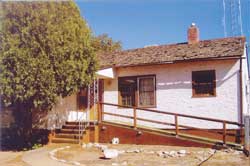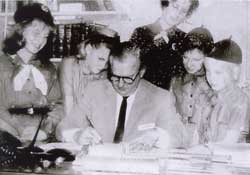November elections can be expected to bring to the surface memories among old-timers of the excitement of seeing a favored son from Moab, former city and county attorney Mitchell Melich, win the Republican nomination for Utah governor.

The historic Mitchel Melich house on 100 East.
Photo by Vicki Barker
|
A mine company president during the Uranium Boom who also served as attorney to uranium millionarie Charlie Steen, Mitchell ended up losing to Democrat Cal Rampton in 1964 but gained even greater political prominence as a presidential appointee to the office of Solitictor of the U.S. Department of the Interior five years later.
This November, the county will be discussing the fate of the home of Mitch Melich and his wife Doris (“Dorie“ Snyder), who both played prominent roles in the Moab community during their 30-year residency, and who exercised considerable influence at the state and national levels after moving to Salt Lake City, then to Washington, D.C. and back again to Salt Lake.
Dorie and Mitch, both natives of Utah and graduates of the University of Utah, married in 1935 and made their first home together in the house on First East in Moab. Melich was an ambitious son of Serbian immigrants. He grew up in Bingham Canyon and worked at Kennecott Copper fulltime while earning an undergraduate degree, then went on to earn a law degree in three years.
A friend encouraged him to move to Moab, which he did with a $300 bank loan, hanging out his shingle at the home on First East, eager to practice law. He soon became the city attorney for $100 a year, also served as county attorney, and within a decade was so popular he won election as the first Republican in 25 years to represent the southeastern area in the state senate. He served two terms and rose to become Senate Minority Leader.
Dorie Melich, whose college studies focused on art and western history, meantime raised a family and devoted countless hours to charitable and civic causes. In 1947, she founded the town’s first Girl Scout troop, which eventually included both of her daughters and many other Moab daughters. She served on Girl Scout committees at the national level and helped establish the Utah Girl Scout Council.
One of her greatest causes was the crusade to cure arthritis, which she was diagnosed with in her 40’s. To advance research on the disease, she helped form the national Arthritis Foundation, founded the Utah/Idaho chapter, and was recognized and appointed by President Ford to the National Arthritis Advisory Board.
Dorie Melich worked closely with Utah Sen. Orrin Hatch in those days, promoting funding for medical research and grants for the arts. She liked to paint, and supported the Utah Arts Council.
Toward the end of Melich’s second term in the Utah Senate, the Uranium Boom hit Moab and Melich met Steen and performed the professional task of drawing up papers for the former Texas geologist to form the Utex Exploration Co. Payment was some stock in Utex.
“I still remember the first time Charlie Steen came to our house looking for Dad to represent him,” recalled Tanya (Melich) Silverman, in an email. “I was in the kitchen washing dishes and wondered who was that strange man with the red coat. As Moab was so small, it was easy to spot a stranger.”
Steen liked to wear a red coat and drive around with his purebred Dalmatian in his red Lincoln convertible.
She also recalled that her father led efforts to build the first swimming pool, across from the old courthouse, “because in a place as hot as Moab, he said, the town needed a pool (and) I spent my childhood at that pool, coming home for lunch and returning to spend as much time as I could there.”
Steen and Melich grew to be close associates and observed that existing uranium mining operations were unable to keep up with demand from the Atomic Energy Commission for processed uranium, so in partnership with Dorie Melich’s father, E.H. Snyder, they formed the Uranium Reduction Company (URECO) and asked the AEC for permission to build a uranium mill in Moab. Melich’s law partner, Hank Ruggeri, bought the land along the Colorado River that became the site of Atlas Corporation’s uranium mill processing plant, dedicated in 1957.

A group of Girl Scouts of Moab with former Moab Mayor and Grand County Commissioner Winford Bunce. Photo courtesy of Vicki Barker |
The Meliches raised four children in the red-rock country -- all of whom have fun and intriguing stories to tell of the boom times in Moab, when movie stars in Hollywood westerns walked the streets and rubbed shoulders with the locals and uranium prospectors pouring in from everywhere in hopes of striking it rich like Charlie Steen. Mrs. Melich and two of her children snagged roles as extras in the John Wayne film, “Rio Grande.”
While the Melich children -- two daughters and two sons -- all live elsewhere now, they keep tabs on the house they grew up in. The girls in particular continue to show a deep interest in the house, and Nancy recently enjoined County Councilmember Audrey Graham to tour the house with her, curious about its condition and its fate.
Grand County bought the Melich house in 2004 in the interest of future county expansion. The home is next door and to the north of the courthouse. Over the years, it has served as office and classroom space for the Grand County School District, as storage and service site for the Grand County Food Bank, and for several years now as storage space.
Nancy made a special request to go through the house again after her mother Dorie died in 2007 (her father died in 1999), and the Melich family wonders about the possibility of historic preservation, Graham said.
“I was amazed when I walked through. The more we can have people walk through it, the better,” Graham said.
While the home is historically significant, nomination to the National Register is not favored by the County Council because the county wants to retain the option of demolition, although right now “it’s not being looked at for demolishing,“ Graham said. “For the county, I know it will be financial considerations. I like to keep our options open, but I’d like to see us keep that building there.”
Graham said the county has talked about building a long hallway to the home in order to keep it intact and in use as office space. “It would make more sense to me to put up another building,” Graham said.
In July, the Grand County Historical Preservation Commission proposed using the building as an official “home” for the 7-member advisory body and its various committees -- to establish an office, and to renovate and preserve the building as an historic structure, archival repository and historical research facility. County Administrator Shawn Warnke recommended against the proposal, but talks continue. Lately, he has been looking into the possibility of the county contracting for student interns who would reside in the home while earning college credits working on county projects.
Historical board members hope for a partnership arrangement in use of the building, possibly starting out with basement use for storing historical records and collections. The group has never occupied county space or had an office in its 22-year history, and members point out that lack of accommodations hampers gathering, research and curating of historical materials.
Some records, files and collections are stored at the Dan O’Laurie Museum of Moab, but the museum -- operated and leased from the county by the private, nonprofit Southeastern Utah Society for the Arts and Sciences -- is also hurting for more space and can offer little more than storage space in filing drawers and back rooms at this point, said historical board member Bette Stanton.
The county’s film memorabilia, once housed by the Moab-to-Monument Valley Film Commission, (which shut down in 2000) are stored or exhibited at the private river-ranch of Colin Fryer, on Highway 128. The film commission has become an official entity of the City of Moab, and the county’s collection remains under lease until 2020 at the Western Heritage Film Museum at Fryer‘s Red Cliffs resort.
Stanton stressed in the proposal for using the Melich home as an archival repository that “over the years, many records for the private and public sector (including businesses), prominent and celebrity citizens, and government, have been lost, disposed of (some actually taken to the dump) or otherwise destroyed, or have become inaccessible because there is no place to safely maintain and properly curate them. These items have been lost, and those that currently face similar fates are valuable not only to coming generations, but currently to researchers and writers interested in the area and its people.”
“A facility is seriously needed to centralize these records for public review and use,” she concluded. Suggestions may be submitted to the County Administrator’s Office at 259-1346. |

